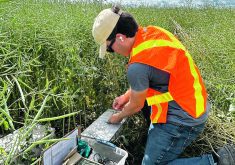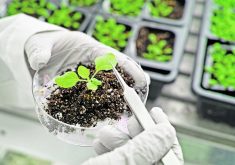DUBLIN, Ireland — Ireland and the United Kingdom may have had their differences over the years, but the two share a strong interdependent business alliance.
Bound by cultural ties, proximity and a common language, the two are each other’s best and largest trading partners. As the U.K. prepares to withdraw from the European Union, that decision to leave the common market has spurred uncertainty.
“From where I sit as secretary general of the department, I break it into two pieces: one is the political negotiations and the other is the commercial impact,” said Aidan O’Driscoll, secretary general of the Irish agriculture department.
Read Also

Farming Smarter receives financial boost from Alberta government for potato research
Farming Smarter near Lethbridge got a boost to its research equipment, thanks to the Alberta government’s increase in funding for research associations.
Trade will continue, but a lot is at stake.
With an annual turnover of $38 billion, agri-food is Ireland’s most important indigenous industry. Last year it exported more than $16 billion worth of products to 175 markets. The U.K. accounts for more than 40 percent of Ireland’s total exports of beef, pork, dairy, poultry and beverages. Twenty-four percent of the U.K.’s agri-food exports worth $4.9 billion went to Ireland.
Related stories in this Special Report:
- After Brexit: how the United Kingdom is coping with a new trade landscape
- English producers prepare for breakup with European Union
- Uncertainty reigns in Scotland as Brexit looms
The deadline for the U.K to leave is March 29, 2019, but many question whether that is achievable. In the meantime, no one wants to slow down commerce.
“The commercial impacts of a Brexit will not wait on the negotiation timeline,” O’Driscoll said at a recent agriculture conference in Naas, Ireland.
“There will be commercial impacts driven by uncertainty and driven by exchange rates.”
The weakening of the pound sterling against the euro has caused disruptions in price stability, but the country is determined to forge ahead with its own trade agenda.
“We saw an immediate impact with the Brexit decision from the exchange rate,” said Angus Woods, who chairs the Irish Farmers Association’s livestock committee and produces lamb, beef and cereals on his County Wicklow farm.
He supports diversification of agriculture and markets outside the U.K., but he is also a realist. A big loser could be the beef trade if disruptions occur. About 270,000 tonnes of Irish beef now goes to the U.K. annually.
“Are we going to find a market to take 270,000 tonnes in the next year and a half or two years at the kind of money the British pay? No, is the short answer,” he said.
Talking about alternative markets is one thing, but the reality could be much different.
He is referring to an ambitious export plan called Food Wise 2025, a 10-year strategy to increase the value of Irish food and beverage exports by 2025 to $27.5 billion.
That strategy means looking beyond the British Isles, said Padraig Brennan, director of international markets for Bord Bia, also known as the Irish Food Board.
“Brexit or no Brexit, companies should be looking at diversification,” he said.
“We are so export oriented, and what happens in the global marketplace affects us more than most.”
Bord Bia is a state agency that promotes Irish agri-food products domestically and abroad. It provides a link between producers and customers and has a network of international offices to help open doors for the Irish food sector.
The Bord Bia Brexit Barometer keeps businesses informed about negotiations and potential changes.
“In the 1990s, the Irish industry was driven by EU policy and the common agriculture policy around support systems and interventions,” Brennan said.
“That left an industry that didn’t have to care as much about exports. It was a challenging time and it was a simpler system, but that is no longer there.”
Part of the business plan includes promoting Ireland as an environmentally friendly food producer through Origin Green, the national food sustainability program. The verification program promotes sustainable agriculture practices from the farm to the retailers and is backed up with regular audits.
“We must show continuous improvement because all countries show continuous improvement. This is a starting point and we have to demonstrate how we are improving,” said Andrew Mullins, sustainability development manager for Bord Bia.
Another strategy is giving customers what they want.
“The industry has invested a lot of time getting to know customer requirements and getting to know the European markets much better than before and looking at adding value,” Brennan said.
“The sector has gotten much better at identifying the niche markets and understanding from an individual customer point of view, what is their desire.”
Canada and the EU signed the Comprehensive Economic and Trade Agreement Sept. 21, and Ireland has looked at Canada as a potential opportunity for meat exports. Lamb may be easier to sell because Canada has a deficit, and the Irish product could be offered as a specialty import.
“We need to understand the market better. We don’t have a tradition of exporting there,” said Brennan.
The most recent figures show that $27.5 million in exports went to Canada, so there is some growth potential.
“CETA gives us an opportunity to grow that further, and I am sure there will be more products coming in this direction as well,” he said.
The bigger prize is the Asia Pacific region.
The EU has approval to ship beef to places such as the Philippines, and last year the country accepted 15,000 tonnes of Irish beef.
A pending deal is expected with China and is likely to be similar to Canada’s agreement because both countries have similar BSE status.
Ireland’s strengths are in beef, pork, dairy, seafood and beverages.
Beef
Ireland produces far more beef than it needs on a landscape that is 80 percent grasslands.
“We produce eight times the amount of beef we need for our population, and we are the largest exporter of beef in the northern hemisphere and fifth largest internationally and we are the largest exporter to EU retailers,” Mullins said.
There are 110,000 cattle farms in Ireland. Processing and selling beef occurs across the country, and raising cattle on grassland is part of the cultural mosaic.
The main challenge for beef farming in Ireland is low income pegged at $19,000 to $23,000 a year.
“We know 40 percent of beef farms have off-farm income,” said Rowena Dwyer, an Irish Farmers Association economist.
Farm incomes are dependent on Common Agriculture Policy payments, but the next round offers less money with conditions attached to environmental sustainability.
Processors seek the highest value markets, which is the U.K.
“We sell to the best market at the best price. For the beef sector, that is what the U.K. is and we shouldn’t, in any of this discussion, lose that focus and lose the focus on influencing and currently asking our government to get agriculture to the top of the EU negotiators’ agenda,” said Dwyer.
In addition, Ireland has built a strong trade selling beef on the hoof to Turkey, Libya, Northern Ireland and the European continent ,where more than 145,000 live animals have been exported.
Pork
While grass-fed beef is widely promoted, Irish pork is also finding overseas acceptance.
China bought 65,000 tonnes of Irish pork this year, and more growth is expected this year.
“At this stage China will be our second biggest market,” Brennan said.
Most of the exports to China were originally offal, but the last three years have seen a swing toward higher quality cuts with decent returns.
“There will always be a very strong demand for the byproducts,” he said.
“The firms here have invested a lot to get to know the market. They have found niche opportunities for muscle meat.”
Dairy
Ireland produces 6.5 billion litres of milk a year, which is processed mainly by farmer-owned co-operatives.
“It is quite small internationally, but we are export focused with 85 percent going internationally,” said Mullins.
Dairy production is focused on value adding with more butter, cheeses, powders and infant milk formulas going to about 80 countries.
The dairy herd has grown from 1.2 million cows to 1.4 million cows with ambitions to grow further.
Last year Irish dairy products earned $870 million in the Chinese market. The Irish products are viewed as clean and produced in a sustainable system with quality controls and traceability.
Seafood
Seafood, especially salmon and shellfish, is a major Irish export to fill a driving demand. Most goes to Asia, where farmed and wild seafood is welcome.
Beverages
The beverage sector has enjoyed a 41 percent increase since 2010 with strong growth in the whisky trade. Built on a well-established malting barley industry, Irish beer and whisky are delivered to 180 countries worldwide worth about $2 billion last year.
The value of Irish whiskey is about $725 million a year with North America considered a prime destination.


















